Traditional Japanese Fly Kabari 1 |
 |
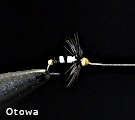 |
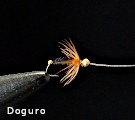 |
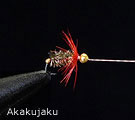 |
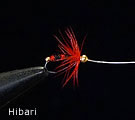 |
|||
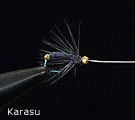 |
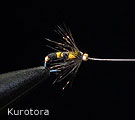 |
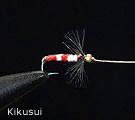 |
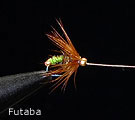 |
|||
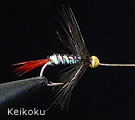 |
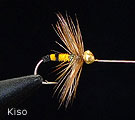 |
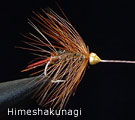 |
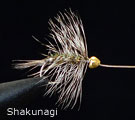 |
|||
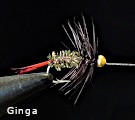 |
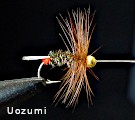 |
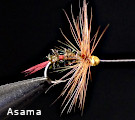 |
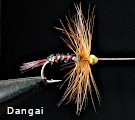 |
|||
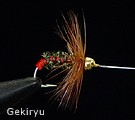 |
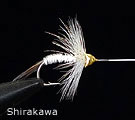 |
 |
 |
|||
Banshu Kabari (Fly)
These are Kebari for Hae, Hasu (Pale chub) and Kebari for Yamame that was called "Kagashira" or "Kabari" that are made and sold in Hyogo Prefecture (Banshu) now.
The upper section are kebari of "Mitsubachi tsuribari Nagao", and the second section are kebari of "Fujisho bari honpo", the third section are kebari of "Morimoto bari" that doesn't exist now, and the forth section, the fifth section are kebari of "Ryuobari honpo".
These kebari are roughly #20-11 in hook size of western style, and all have names and there are a lot of kinds.
The Kindama (gold ball) on the head of Kabari looks like the heavy western style fly beads,
but this is made to beads by kneading Urushi (Japanese lacquer) and red lead primer or polishing powder, and it is pasted gold leaf, so this does not have a weight that much.The kebari appears to the book "Kyo suzume ato oi" published in 1678 for the first time as "Haegashira". "Haegashira" fishing was begun as fishing of Hae, Hasu (Pale chub) or the Ugui (Japanese dace) in Kyoto. (Standard Japanese name of Hae or Hasu is Oikawa, and it is called Yamabe in Kanto.) The specialized kebari for Ayu (Sweet fish) fishing were created and developed, because these kebari were also possible to fish the Ayu. These were called "Kagashira" and "Kabari" around the end of 1700s. In many han (domain) such as Akita Kubota Han, Yamagata Shonai Han, Ishikawa Kaga Han, Hyogo Banshu Himeji Han, Kochi Tosa Han, fishing was encouraged as one of the training of samurai's mind and body because the Edo Period became a peaceful age without the war, and the fishhook industry also was encouraged at the same time. Since these kebari were also possible to fish the Yamame or Amago, it seems that these were improved also as the kebari of Yamame or Amago on the other hand. There is an illustration of five kinds of Kabari in the book "Kawagari-Tebiki" published in 1834. One is a kebari that is larger than another that is called "Hachigashira" and there being much area in which Hae (Hasu), Ugui, Ayu and Yamame or Amago lives together, it has the possibility that is a kebari for Yamame or Amago. It can be guessed so because they are written as "Yamame Kebari" in the old bag of larger kebari of Yamamo and Katsuoka. However, it is considered that simultaneously with this kabari fishing "Urban Kebari Fishing", the kebari fishing "Mountain Village Kebari Fishing" of Yamame, Amago and Iwana had been done by the people and the fisherman in the mountain village in various places while applying their own improvement. "Kabari-Nagashi" of the ukiyoe "Chie-no-umi (One Thousand Pictures of the Ocean)" by Katsushika Hokusai that was drawn the states of the various fishing, and was published around 1833. It is completely the same as "kagashira fishing" handed down in Kumamoto (Higo) that uses a bamboo rod of 190cm (6.3ft) or 270cm (8.9ft), a taper line of horse tail, a tippet, a Kebari, 2 droppers and a ukedamo with the net made from hemp. Also, it is very similar to Kagashira fishing of "Hyogo-ken Gyogu Zukai (Illustrations of fishing devices of the prefecture of Hyogo)" edited in 1897 except for using four kebari. Moreover, It is written "Yamabe fishing in mountainous areas of Nishitama-gun Musashi-no-kuni (omission of a sentence) is done with three bee-shaped flies" in the section on "Yamabe fishing" of "Nihon suisan hosaishi (The record of Japanese fishing)" issued in 1912. Yamabe is Yamame, and bee-shaped flies are Hachigashira which are a large size kabari. It can understand that "Nagashi tsuri" that has a number of kebari had been performed widely in Urban area and Mountain village area from 1600's to the early 1900's. It is just like the present Tenkara fishing with the exception of using plural kebari. (Some traditional kebari fishing has the kakebari (snag-hook) in addition to a kebari.) I imagine that the two kebari fishing are not unrelated and they have been influenced on each other in long history and have been handed down. After that, the environment of fishing place changed due to river development and development of railroads and road networks, and the fishing using one kebari became mainstream in the south from Northern Tohoku Region. The present day "Nagashi tsuri" is a fishing method that uses 5-9 many droppers and a float. References: Ministry of Agriculture and Commerce Fisheries Bureau (Ed.) (1979). Yamabe tsuri. Nihon Suisan Hosaishi [The record of Japanese fishing]. Reprinted edition, Tokyo: Ateneshobo. Nagata, K. (1987). Edojidai karano Tsuri [Fishing from Edo period]. Tokyo: Shinnihon-shuppansha. Noma, K. (1976). Shinshu Kyoto Sosho, 1, Kyoto: Rinsen Book. Oda, J. (1999). 'Kasenroku' o yomu [Reads 'Kasenroku']. Tokyo: Tsuribitosha. Oda, J. (2001). Edo Chojutsu Hiden [Secret Fishing Techniques of Edo]. Tokyo: Soubunsha. Takasaki, T. (Ed.) (1981). Nihon Chogu Taizen [Japanese Fishing tackle Encyclopedia]. Tokyo: Kasakura Publishing. Utano, T. (2006). Kagashira no genryu o saguru [Exploring the origins of Kagashira fly]. Fishing Cafe, 23, Osaka: Shimano. KWANSEI GAKUIN University Library Digital library. Hyogoken Gyogu Zukai Kagashira fishing, Retrieved February 24, 2019. National Diet Library Digital Collections. Kawagari-Tebiki Illustration of five Kabari, Retrieved August 29, 2012. TOKYO NATIONAL MUSEAM Digital Research Archives. Chie-no-umi Kabari-Nagashi, Retrieved May 9, 2012. Kaga Kebari Meboso Hachirobei Company. Retrieved May 7, 2011. Traditional Crafts Banshu Kebari. Retrieved May 7, 2011. |
||||||
Flies |
Equipment |
| Back to Main Home Page | Profile | Links |
Home |
Paper Craft of Japanese Trout and the World Trout © 1997 Yoshikazu Fujioka |